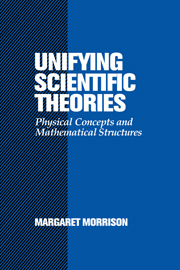Book contents
- Frontmatter
- Contents
- Acknowledgements
- Introduction
- 1 The Many Faces of Unity
- 2 Unification, Realism and Inference
- 3 Maxwell's Unification of Electromagnetism and Optics
- 4 Gauges, Symmetries and Forces: The Electroweak Unification
- 5 Special Relativity and the Unity of Physics
- 6 Darwin and Natural Selection: Unification versus Explanation
- 7 Structural Unity and the Biological Synthesis
- Conclusions
- Notes
- References
- Index
4 - Gauges, Symmetries and Forces: The Electroweak Unification
Published online by Cambridge University Press: 06 October 2009
- Frontmatter
- Contents
- Acknowledgements
- Introduction
- 1 The Many Faces of Unity
- 2 Unification, Realism and Inference
- 3 Maxwell's Unification of Electromagnetism and Optics
- 4 Gauges, Symmetries and Forces: The Electroweak Unification
- 5 Special Relativity and the Unity of Physics
- 6 Darwin and Natural Selection: Unification versus Explanation
- 7 Structural Unity and the Biological Synthesis
- Conclusions
- Notes
- References
- Index
Summary
In Chapter 3 we saw how Maxwell's theory incorporates two different aspects of unity: the reductive and the synthetic. We also saw the different ontological and explanatory features associated with each. In this chapter we shall look more closely at a case of synthetic unity, one that integrates the electromagnetic and weak forces. The electroweak theory provides a unified structure within which electromagnetic and weak interactions can be integrated, and yet the particles that carry the forces remain distinct. Hence, at the level of particle ontology we do not have the kind of reduction that is present in Maxwell's unification of electromagnetism and optics, where the processes are identified with each other. Yet we do have a kind of theoretical unification in terms of the gauge theory SU(2) × U(l) that describes the mixing of the two fields. In this latter sense the history is remarkably like that of electrodynamics, insofar as the unification requires the presence of a mathematical structure and a particular theoretical parameter: specifically, gauge theory (symmetry) and the Weinberg angle, which represents the combination of the coupling constants for weak and electromagnetic processes.
What makes this case especially interesting is that if theoreticians had considered only the physical similarities between electromagnetic and weak interactions that might have made them candidates for unification, it is unlikely that any such unification attempt would ever have been undertaken. But the applicability of gauge theory and symmetry principles provided a powerful mathematical framework that created not only the context but also the mechanism for generating a synthetic rather than a reductive unity of these two processes.
- Type
- Chapter
- Information
- Unifying Scientific TheoriesPhysical Concepts and Mathematical Structures, pp. 109 - 146Publisher: Cambridge University PressPrint publication year: 2000



